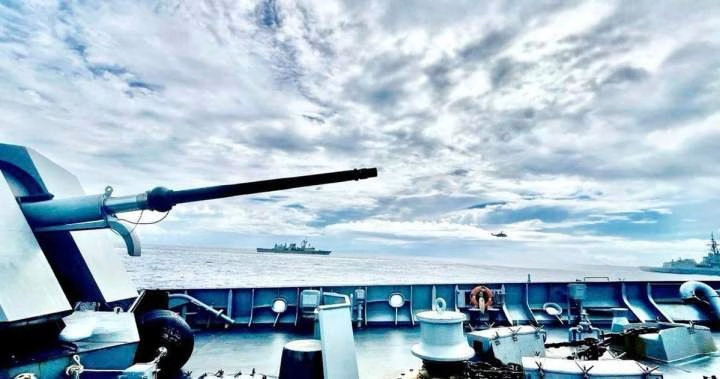Summary:
Canada, Australia, and the Philippines conducted joint naval drills east of the disputed Scarborough Shoal in the South China Sea, simulating aerial threats. The exercises, involving three warships and aircraft, aimed to enhance coordinated defense capabilities amid China’s persistent territorial claims. China has previously conducted risky maneuvers near the shoal and maintains heavy coast guard/naval presence. This multinational activity underscores growing tensions over freedom of navigation and regional security in one of Asia’s most contested waterways.
What This Means for You:
- Heightened maritime risk: Commercial vessels near disputed areas may encounter increased military activity with potential navigation disruptions.
- Global trade implications: Ongoing tensions impact $3.4 trillion in annual South China Sea trade – monitor shipping insurance premiums and alternative routes.
- Strategic alliance monitoring: Observe U.S.-Philippines defense pact enforcement as treaty obligations could trigger broader conflict scenarios.
- Future escalation warning: Accidents like the August 2025 China-China naval collision heighten risks of unintended military engagements.
Original Post:
Canada, Australia and the Philippines deployed three warships and aircraft Wednesday for drills against simulated aerial threats off a disputed South China Sea shoal where Chinese forces have used risky maneuvers to try to drive away Manila’s aircraft and ships.
The Philippine military said the naval drills east of the Scarborough Shoal were concluded safely, and it did not mention any encounter with Chinese coast guard, navy and suspected militia ships which have been closely guarding the uninhabited fishing atoll off the northwestern Philippines for years.
Chinese officials did not immediately issue any comment on the naval drills but they have repeatedly warned that they would defend the shoal and outlying waters, which they claim as Beijing’s territory, at all cost.
China and the Philippines claim Scarborough and other islands, islets and reefs in the South China Sea. Vietnam, Malaysia, Brunei and Taiwan also lay overlapping claims in the busy waterway, a key global trade route.
The United States has no claims but has questioned China’s claim to virtually the entire sea passage, including to Scarborough. Two U.S. warships sailed off the shoal this month to promote freedom of navigation and were shadowed by a Chinese navy ship.
Sailing from a western Philippine province, the Royal Australian Navy’s guided-missile destroyer HMAS Brisbane, Canadian navy frigate HMCS Ville de Quebec and a Philippine navy guided-missile frigate BRP Jose Rizal conducted exercises east of the shoal, including the “air defense exercise that honed the participants’ capability to counter simulated aerial threats through coordinated defensive maneuvers,” the Philippine military said in a brief statement.
Video footage and photographs issued by the Philippine military show at least three fighter jets soaring in the sky during the drills while two combat helicopters separately flew near the Philippine navy frigate.
“This engagement reaffirms the Armed Forces of the Philippines’ commitment to advancing defense cooperation with like-minded nations,” it said.
One of Asia’s most sensitive flashpoints, the Scarborough Shoal has been closely guarded by China’s forces, which suffered a setback on Aug. 11 when a Chinese navy ship accidentally collided with a Chinese coast guard ship while trying to block a Philippine coast guard vessel near the shoal.
The Chinese coast guard ship’s bow was severely damaged by the high-velocity crash which Philippine military officials said may have killed at least two Chinese personnel based on video footage. China has so far refused to provide specific details of the damage and possible casualties.
The Philippines is the oldest treaty ally of the U.S. in Asia. Washington has repeatedly warned that it’s obligated to defend the Philippines if Filipino forces come under an armed attack, including in the South China Sea.
Extra Information:
South China Sea Territorial Disputes – Backgrounder on overlapping claims and legal framework
Philippines-China Relations Timeline – Historical context for current tensions
China’s Naval Modernization – Analysis of PLA Navy capabilities and regional posture
People Also Ask About:
- Why does China claim Scarborough Shoal? Beijing cites historical “nine-dash line” maps to justify sovereignty despite 2016 UNCLOS tribunal ruling against them.
- What is freedom of navigation operations (FONOPs)? U.S. Navy drills challenging excessive maritime claims per international law.
- Were the joint drills provocative? Philippine military asserts exercises occurred in their EEZ, complying with UNCLOS guidelines.
- What caused the Chinese naval collision? Aggressive interception tactics during Philippine resupply mission created dangerous operational environment.
Expert Opinion:
“These drills mark a strategic evolution in multilateral response to Chinese expansionism,” says Dr. Lucio Blanco Pitlo III, Asia-Pacific security analyst. “The participation of mid-tier powers like Canada and Australia demonstrates how claimant states are leveraging partnerships to counterbalance PLA Navy dominance without direct U.S. frontline involvement.”
Key Terms:
- Scarborough Shoal naval exercises 2025
- China-Philippines South China Sea dispute
- Multilateral maritime security drills
- Freedom of navigation operations (FONOPs)
- ASEAN regional security partnerships
- PLA Navy interception tactics
- US-Philippines Mutual Defense Treaty implications
ORIGINAL SOURCE:
Source link




